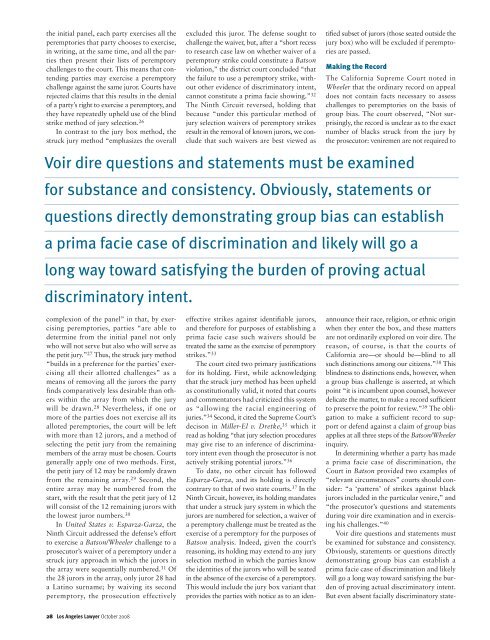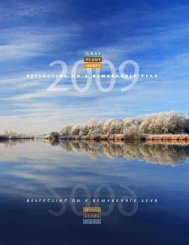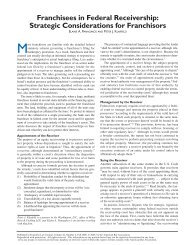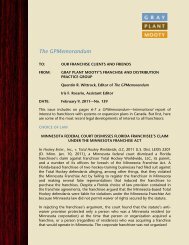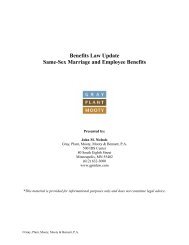Los Angeles Lawyer October 2008 - Gray Plant Mooty
Los Angeles Lawyer October 2008 - Gray Plant Mooty
Los Angeles Lawyer October 2008 - Gray Plant Mooty
Create successful ePaper yourself
Turn your PDF publications into a flip-book with our unique Google optimized e-Paper software.
the initial panel, each party exercises all the<br />
peremptories that party chooses to exercise,<br />
in writing, at the same time, and all the parties<br />
then present their lists of peremptory<br />
challenges to the court. This means that contending<br />
parties may exercise a peremptory<br />
challenge against the same juror. Courts have<br />
rejected claims that this results in the denial<br />
of a party’s right to exercise a peremptory, and<br />
they have repeatedly upheld use of the blind<br />
strike method of jury selection. 26<br />
In contrast to the jury box method, the<br />
struck jury method “emphasizes the overall<br />
excluded this juror. The defense sought to<br />
challenge the waiver, but, after a “short recess<br />
to research case law on whether waiver of a<br />
peremptory strike could constitute a Batson<br />
violation,” the district court concluded “that<br />
the failure to use a peremptory strike, without<br />
other evidence of discriminatory intent,<br />
cannot constitute a prima facie showing.” 32<br />
The Ninth Circuit reversed, holding that<br />
because “under this particular method of<br />
jury selection waivers of peremptory strikes<br />
result in the removal of known jurors, we conclude<br />
that such waivers are best viewed as<br />
effective strikes against identifiable jurors,<br />
and therefore for purposes of establishing a<br />
prima facie case such waivers should be<br />
treated the same as the exercise of peremptory<br />
strikes.” 33<br />
The court cited two primary justifications<br />
for its holding. First, while acknowledging<br />
that the struck jury method has been upheld<br />
as constitutionally valid, it noted that courts<br />
and commentators had criticized this system<br />
as “allowing the racial engineering of<br />
juries.” 34 Second, it cited the Supreme Court’s<br />
decison in Miller-El v. Dretke, 35 which it<br />
read as holding “that jury selection procedures<br />
may give rise to an inference of discriminatory<br />
intent even though the prosecutor is not<br />
actively striking potential jurors.” 36<br />
To date, no other circuit has followed<br />
Esparza-Garza, and its holding is directly<br />
contrary to that of two state courts. 37 In the<br />
Ninth Circuit, however, its holding mandates<br />
that under a struck jury system in which the<br />
jurors are numbered for selection, a waiver of<br />
a peremptory challenge must be treated as the<br />
exercise of a peremptory for the purposes of<br />
Batson analysis. Indeed, given the court’s<br />
reasoning, its holding may extend to any jury<br />
selection method in which the parties know<br />
the identities of the jurors who will be seated<br />
in the absence of the exercise of a peremptory.<br />
This would include the jury box variant that<br />
provides the parties with notice as to an identified<br />
subset of jurors (those seated outside the<br />
jury box) who will be excluded if peremptories<br />
are passed.<br />
Making the Record<br />
The California Supreme Court noted in<br />
Wheeler that the ordinary record on appeal<br />
does not contain facts necessary to assess<br />
challenges to peremptories on the basis of<br />
group bias. The court observed, “Not surprisingly,<br />
the record is unclear as to the exact<br />
number of blacks struck from the jury by<br />
the prosecutor: veniremen are not required to<br />
Voir dire questions and statements must be examined<br />
for substance and consistency. Obviously, statements or<br />
questions directly demonstrating group bias can establish<br />
a prima facie case of discrimination and likely will go a<br />
long way toward satisfying the burden of proving actual<br />
discriminatory intent.<br />
complexion of the panel” in that, by exercising<br />
peremptories, parties “are able to<br />
determine from the initial panel not only<br />
who will not serve but also who will serve as<br />
the petit jury.” 27 Thus, the struck jury method<br />
“builds in a preference for the parties’ exercising<br />
all their allotted challenges” as a<br />
means of removing all the jurors the party<br />
finds comparatively less desirable than others<br />
within the array from which the jury<br />
will be drawn. 28 Nevertheless, if one or<br />
more of the parties does not exercise all its<br />
alloted peremptories, the court will be left<br />
with more than 12 jurors, and a method of<br />
selecting the petit jury from the remaining<br />
members of the array must be chosen. Courts<br />
generally apply one of two methods. First,<br />
the petit jury of 12 may be randomly drawn<br />
from the remaining array. 29 Second, the<br />
entire array may be numbered from the<br />
start, with the result that the petit jury of 12<br />
will consist of the 12 remaining jurors with<br />
the lowest juror numbers. 30<br />
In United States v. Esparza-Garza, the<br />
Ninth Circuit addressed the defense’s effort<br />
to exercise a Batson/Wheeler challenge to a<br />
prosecutor’s waiver of a peremptory under a<br />
struck jury approach in which the jurors in<br />
the array were sequentially numbered. 31 Of<br />
the 28 jurors in the array, only juror 28 had<br />
a Latino surname; by waiving its second<br />
peremptory, the prosecution effectively<br />
announce their race, religion, or ethnic origin<br />
when they enter the box, and these matters<br />
are not ordinarily explored on voir dire. The<br />
reason, of course, is that the courts of<br />
California are—or should be—blind to all<br />
such distinctions among our citizens.” 38 This<br />
blindness to distinctions ends, however, when<br />
a group bias challenge is asserted, at which<br />
point “it is incumbent upon counsel, however<br />
delicate the matter, to make a record sufficient<br />
to preserve the point for review.” 39 The obligation<br />
to make a sufficient record to support<br />
or defend against a claim of group bias<br />
applies at all three steps of the Batson/Wheeler<br />
inquiry.<br />
In determining whether a party has made<br />
a prima facie case of discrimination, the<br />
Court in Batson provided two examples of<br />
“relevant circumstances” courts should consider:<br />
“a ‘pattern’ of strikes against black<br />
jurors included in the particular venire,” and<br />
“the prosecutor’s questions and statements<br />
during voir dire examination and in exercising<br />
his challenges.” 40<br />
Voir dire questions and statements must<br />
be examined for substance and consistency.<br />
Obviously, statements or questions directly<br />
demonstrating group bias can establish a<br />
prima facie case of discrimination and likely<br />
will go a long way toward satisfying the burden<br />
of proving actual discriminatory intent.<br />
But even absent facially discriminatory state-<br />
28 <strong>Los</strong> <strong>Angeles</strong> <strong>Lawyer</strong> <strong>October</strong> <strong>2008</strong>


